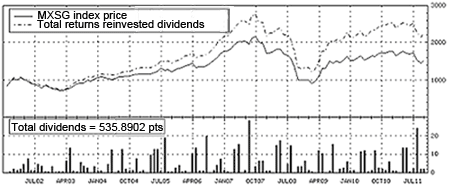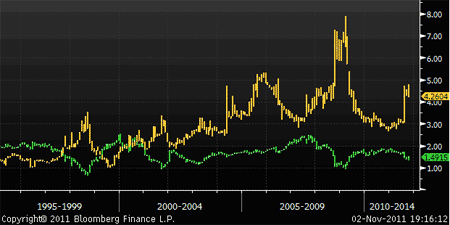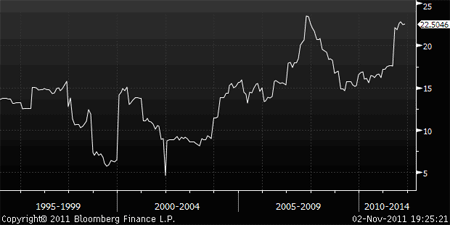Looking for income? You should invest in Singapore
As the global economy worsens, Singapore - with its dividend-culture and rising dollar - offers a refuge for investors looking for better returns. Here, Cris Sholto Heaton tips the best Singapore-listed stocks to buy now.

Panics are usually kind to the income-seeking investor. Everything sells off hard even good-quality, high-dividend stocks sell off to the kind of levels you don't see in a regular bear market.
Back in early 2009, for example, I wrote about Singapore real estate investment trusts (Reits). With credit markets frozen, investors were terrified these Reits wouldn't be able to refinance their debts. Absolutely first-class stocks such as Ascendas Reit were trading on yields of 12-15%. It was an outstanding buying opportunity.
Given all the fear around today, some of you have asked whether there are any similar bargains to be had now. Unfortunately, the markets haven't been as kind to us this time around. Most S-Reits are barely down this year, as investors treat them as a defensive play.
MoneyWeek
Subscribe to MoneyWeek today and get your first six magazine issues absolutely FREE

Sign up to Money Morning
Don't miss the latest investment and personal finances news, market analysis, plus money-saving tips with our free twice-daily newsletter
Don't miss the latest investment and personal finances news, market analysis, plus money-saving tips with our free twice-daily newsletter
Still, Singapore income stocks are definitely worth a look. We can't do as well as we did in 2009, but some blue-chip stocks look pretty good value.
Why Singapore stocks are good for income
For foreign investors seeking an income, there are two good long-term reasons to invest in Singapore.
The first is that the Singapore dollar is likely to rise against sterling, the US dollar and the euro (if it still exists) over time. So you should see substantial currency gains on your dividends over a five to ten-year period.
The second is that Singapore has a very strong dividend culture. Firms tend to start paying out relatively early on. And because the market is seen as less of a growth play than most of its neighbours, valuations tend to be lower. So you can find a number of large, well-run firms offering dividend yields in the 4-6% range.
The chart below demonstrates this quite well. It shows the performance of the MSCI Singapore index over the last decade.

(Source: Bloomberg)
The key two lines to look at are 'Simple Price Appreciation' and 'Gross divs reinvested into index'. The basic price return (the solid black line above) has been around 80%, or 6% per year decent given what's been going on. But once you factor in dividends received and reinvested (the dotted black line), that rises to a very good 170% or 10.5% a year.
The Singapore market isn't at rock-bottom valuations. But as the chart below shows, it's looking reasonably good value.

The price/book ratio (green line) is 1.5, against a 15-year average of 1.7. And the dividend yield (yellow line) is 4.3%. That's against an average of 2.8%.
We need to be careful, because we're probably approaching peak earnings for the cycle. Profit margins are high as the return on equity chart (a key measure on profitability) below shows. The most likely way from here is down.

I would expect earnings and dividends to fall at many firms. For example, shipping firm NOL just announced a third quarter loss. This was seen as a bad omen for the sector, since NOL is one of the best in the business. It's on a trailing yield of 4.1%, but I doubt that will be sustained.
Still, even allowing for that, the market is probably offering an above-average yield. And there are high-quality firms with steady dividends that are now trading on pretty attractive yields after the recent sell-off.
The best income stocks in Singapore
So which names should you consider? I'll limit this to at least mid-sized firms (S$1bn market cap and up). There are some great smaller firms around, but I'll stick to the very secure prospects for now.
The most obvious suggestion is Singapore Telecommunications (SingTel). This is the largest stock on the Singapore exchange and the largest telecoms group in Singapore. It also has a number of investments in other markets directly in Australia and through minority investments in countries such as India, Indonesia and Thailand.
Frankly, several of the overseas businesses have been a drag on performance in recent years, as is the case with a lot of multinational telecoms firms. But they may start to contribute more in the near future, with competition falling in many markets. On a trailing yield of 5%, there should be steady upside for SingTel's dividend.
You could also look at Starhub, which is the second-largest mobile operator and main cable TV firm. But it's had a rather strong run this year and is yielding about a percentage point more than SingTel, a smaller gap than usual. I see SingTel as better value at this price.
My next suggestion may sound slightly insane even to me. I have a long-standing aversion to the aviation business. It has a long and sorry record of destroying shareholder value. But Singapore Airlines is unusually competent. It even managed to stay profitable and dividend paying in 2009, thanks to contributions from its terminal services business SATS and maintenance arm SIA Engineering.
SATS and SIA Engineering are separately listed. Both offer good yields (4.6% and 5.4% respectively). And they maintained stable earnings and payouts through the global crisis. They are the more conservative way to invest in the group. But shares in the parent company have collapsed in recent weeks amid worries about global growth. They're not far above their 2009 lows and the trailing yield is 5.2%.
That's based on a payout of S$0.60 a year. Will that be maintained in a severe slowdown? No. Analysts expect S$0.40 for the coming year, while during the crisis it was cut to S$0.12. But based on Singapore Airlines' past record, a larger payout should return quickly when conditions improve. And the shares should rebound as well.
If you are going to buy a stock like this, cyclical troughs are the time to do so. The income won't be steady, but it should be decent over time and there's a good chance of capital gains.
Aerospace and defence is always a popular sector for steady income, and Singapore Technologies Engineering is well worth a look. It provides engineering services to military and civilian customers around the world in aviation, electronics, naval and land systems. The stock currently yields 5.1% and growth should be steady, if unexciting.
One I'm less certain of is Singapore Post. It is popular with many dividend investors. And it's on an unusually high yield of 6%, which is probably completely secure in the short term. But like most postal services, the traditional business is declining, and there is a question mark over whether it will manage to grow other areas enough to make up for this. It might be worth buying at current prices, but I wouldn't chase it any higher a business like this should offer an exceptional dividend if it's not going to offer much else.
There are similar questions about Singapore Press Holdings (SPH), which has a dominant share of the local newspaper and magazine business. It's in an extremely strong position for now, but media business is changing.
It's hard to know whether a company that's so used to being unchallengeable has the kind of mindset to adapt to a new era. But SPH is certainly starting from a position of strength and has plenty of options. A yield of 6.1% is probably fair.
Lastly, don't just focus on the highest-yielding stocks. Some with slightly lower yields may have better dividend growth prospects. One example would be Overseas Chinese Banking Corporation (OCBC), which has good prospects regionally and in private banking. It currently yields 3.7%.
And after a 20% sell-off this year, stock and derivatives exchange operator Singapore Exchange looks attractive, if you believe that Asian financial markets will continue to grow and that Singapore will remain a major financial centre in the years ahead. The trailing yield is 4.2%.
Get the latest financial news, insights and expert analysis from our award-winning MoneyWeek team, to help you understand what really matters when it comes to your finances.
Cris Sholto Heaton is an investment analyst and writer who has been contributing to MoneyWeek since 2006 and was managing editor of the magazine between 2016 and 2018. He is especially interested in international investing, believing many investors still focus too much on their home markets and that it pays to take advantage of all the opportunities the world offers. He often writes about Asian equities, international income and global asset allocation.
Cris began his career in financial services consultancy at PwC and Lane Clark & Peacock, before an abrupt change of direction into oil, gas and energy at Petroleum Economist and Platts and subsequently into investment research and writing. In addition to his articles for MoneyWeek, he also works with a number of asset managers, consultancies and financial information providers.
He holds the Chartered Financial Analyst designation and the Investment Management Certificate, as well as degrees in finance and mathematics. He has also studied acting, film-making and photography, and strongly suspects that an awareness of what makes a compelling story is just as important for understanding markets as any amount of qualifications.
-
 Why you fear money – and how to fix it: MoneyWeek Talks
Why you fear money – and how to fix it: MoneyWeek TalksPodcast MoneyWeek's digital editor, Kalpana Fitzpatrick, speaks to financial psychotherapist Vicky Reynal about how to change your money mindset for the better.
-
 How cancelling unused direct debits could boost your pension by £37,000
How cancelling unused direct debits could boost your pension by £37,000A new year refresh of your spending could save you money and help boost your pension pot.
